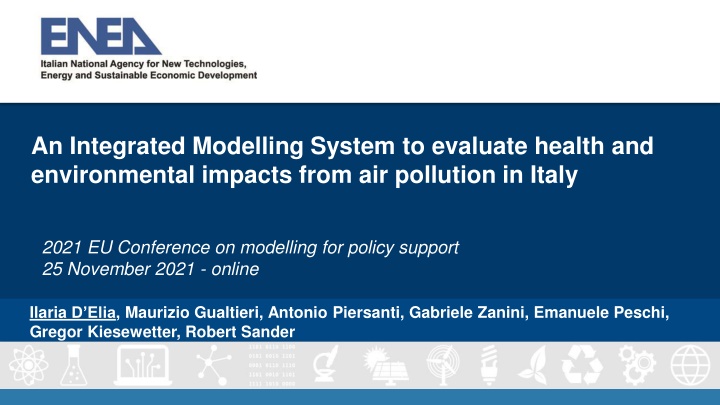
Health and Environmental Impacts of Air Pollution in Italy
Explore the integrated modelling systems and assessment models used in Italy to evaluate the effects of air pollution and climate change policies. Learn about the Italian National Air Pollution Control Programme, projects like PULVIRUS, and the implications on health, environment, and economy. Discover the potential benefits and challenges in meeting air quality standards and mitigating pollution impacts.
Download Presentation

Please find below an Image/Link to download the presentation.
The content on the website is provided AS IS for your information and personal use only. It may not be sold, licensed, or shared on other websites without obtaining consent from the author. If you encounter any issues during the download, it is possible that the publisher has removed the file from their server.
You are allowed to download the files provided on this website for personal or commercial use, subject to the condition that they are used lawfully. All files are the property of their respective owners.
The content on the website is provided AS IS for your information and personal use only. It may not be sold, licensed, or shared on other websites without obtaining consent from the author.
E N D
Presentation Transcript
An Integrated Modelling System to evaluate health and environmental impacts from air pollution in Italy 2021 EU Conference on modelling for policy support 25 November 2021 - online Ilaria D Elia, Maurizio Gualtieri, Antonio Piersanti, Gabriele Zanini, Emanuele Peschi, Gregor Kiesewetter, Robert Sander
MINNI: the Italian National Integrated Assessment Model Integrated Approach: To assess the potential effects of new policies and measures aiming at reducing air pollution and climate change and their relative impacts Different projects: NAPCP for the NEC Directive; Project Pulvirus to understand the effect of COVID-19 restrictions on air quality 2021 EU Conference on modelling for policy support - 22/26 November 2021
The first Italian National Air Pollution Control Programme WAM Compliance with NEC target but what happens to air quality? PM2.5 PM2.5 Year2010 PM2.5 2030 WAM 2030 WAM - 2010 2030 Ceilings: non compliance for WM (With Measure) scenario (all pollutants but SO2) Additional measures needed (WAM) EU limit values attained but far from the WHO limits And what about health and environment impacts? 2021 EU Conference on modelling for policy support - 22/26 November 2021
Health & Environmental Impacts PM2.5 Mortality rate - WM and WAM Ozone AOT40 vegetation - WAM Year2010 2030 WAM 2030 WAM - 2010 WM Mortality rate (number of deaths per 10000 inhabitants) May to July Targe value: 18 000 g/m3 Directive 2008/50/EC WM substantially number of expected deaths impacts on WAM brings an economical benefit equal to 2.05 % of Italian 2010 GDP, mainly in the Po Valley hot-spot, but not negligible (>1%) in several regions WAM brings few minor benefits and more efforts are needed the Piersanti et al., 2021. Atmosphere, doi: 10.3390/atmos12020196 2021 EU Conference on modelling for policy support - 22/26 November 2021
The project PULVIRUS: The effects of lockdown measures on air quality in Italy In the simulated period (Feb-May 2020): Total NOXemission reductions vary from 12% to 18%; Total PM2.5emission reductions vary from 0.5% to 8%; NO2concentration reductions vary from 1 to 9 g/m3, higher in urban areas O3concentration reductions in rural areas and increases in urban areas (to 13%); PM concentrations (not shown): small variations, more relevant in Po Valley. NO2 The aim of the project is to understand how air quality models reproduce significant emission variations in a very short period; the emission variations from specific sectors affected by the COVID-19 restrictions; the effect on secondary pollutants. g/m3 O3 1. Effects on secondary pollutants should be carefully studied. 2. Reduction measures should be carefully selected. 3. Integrated Approach needed. g/m3 2021 EU Conference on modelling for policy support - 22/26 November 2021
What we have learnt These activities tested the robustness of model responses for policy support, both on short term severe emission reductions and on long term air quality plans. The complexity of the interactions and feedback of human activities with/to the environment require modelling tools that can apply HOLISTIC APPROACHES. Our results show the importance to evaluate new policies considering the impacts of different environmental stressors on health and other targets (vegetation, cultural heritage). Urgent need of integrated models to evaluate the impacts of expected integrated policies (on energy, air pollution and climate) to tackle possible negative effects on air quality and climate change. 2021 EU Conference on modelling for policy support - 22/26 November 2021
Ilaria DElia ilaria.delia@enea.it 2021 EU Conference on modelling for policy support - 22/26 November 2021



















